How to Help a Child with Dysgraphia at Home
Are you trying to figure out how to help a child with dysgraphia at home? I’m excited to share some strategies I used over the years to help my son overcome his writing challenges.
While this is something he will always have to deal with, we have definitely seen significant improvement in his writing through consistent modifications, remediation, and accommodations.
When kids are younger, the focus needs to be on building up their fine motor and visual-spatial skills that are essential to writing and then moving on to more in-depth writing processes.
Remember, the goal isn’t perfection. It’s helping your child be able to express himself clearly through the process of writing.
This post contains affiliate links.
Dysgraphia Understood
Miriam Webster defines dysgraphia as an “impairment of handwriting ability that is characterized chiefly by very poor or often illegible writing or writing that takes an unusually long time and great effort to complete.”
Meaning, kids with this neurological disorder struggle with the physical act of writing. They have poor fine motor, visual, and processing skills. It affects handwriting, spelling, and typing.
While the challenge of getting thoughts out of your head isn’t necessarily a symptom of dysgraphia, it is a secondary result. When a child has to spend so much time and energy physically forming letters and words, it often gets in the way of forming ideas.
One of the first signs parents notice is messy handwriting.
Other things to watch out for are:
- the spacing of letters
- consistency in letter size
- the ability to write in a straight line
- holding a pencil correctly
- controlling the pencil and paper
This learning disability affects more than just handwriting, though. When kids can’t form letters correctly, they will most likely struggle with spelling. Often, they’re also slow writers because it takes an enormous amount of energy and focus to get the letters correct. It may even be a challenge for your child to draw and color.
It’s important to understand that if your child suffers from dysgraphia, he is not being lazy. He just needs some extra help to get on the right track.
Over the course of a couple of years, my son completed vision and language therapy programs which helped in a variety of ways, but as the months went on, he continued to struggle with writing.
When he was 10, we finally met with a school psychologist and she helped us identify the signs of dysgraphia.
For more information about dysgraphia, visit the National Center for Learning Disabilities.
What Does Dysgraphia Look Like
Every situation is unique, but this is what dysgraphia looked like for my son.
I didn’t know that he had dysgraphia when I was teaching him how to write. When he was young, he did not like to draw or write because he couldn’t find a comfortable way to hold a pencil.
As he got older, his handwriting was very inconsistent. Words and sentences were often a combination of upper and lowercase letters, with no spacing between words.
When most kids were writing 1-3 paragraph essays, he struggled to get a complete sentence on a page. He knew what he wanted to say, but he could not get his thoughts on paper.
We were frustrated and confused.
Like with most families, it took time, patience, and a good bit of work to understand what was going on.

How to Help a Child with Dysgraphia
The advice we received was to find various strategies to address the situation. We needed a three-pronged approach:
- remediation – additional training/instruction for writing
- modifications – altering expectations/requirements
- accommodations – alternatives to writing
Over the years, we have searched and researched, and through trial and error found several approaches that have ultimately helped our son.
Every situation is unique, so not all of these may work for your child, but these are the tools and strategies that have worked for our family as we taught our son how to write.
Helpful Dysgraphia Writing Tools
Here are a bunch of the tools we use in our homeschool to help my son get comfortable writing.
Pencils
Gripping the pencil is a huge issue for my son. We’ve tried lots of things, like using pencil grips. There are many sizes and styles of pencil grips and after testing several them, he finally found one that was comfortable.
He also found it was easier to use shorter pencils because they were easier to control.
Copy Work
My son is now a teenager, but we still practice handwriting daily by using copy work. We look at it like we’re constantly strengthening a muscle.
To make this activity more enjoyable, choose copy work that is interesting and meaningful for your child. For my son, that meant something related to history.
He worked his way through many of the Handwriting by George books and is now using Write From History.
Graph Paper
The lines on graph paper help keep columns straight and neat, which is great for keeping kids with dysgraphia focused. It’s also a must for working through math problems.
Speaking of math…consider reducing the number of problems required on a page, so your child doesn’t get overwhelmed. Maybe just have him complete the odd or even problems instead of everything on the page. Just enough to show that he understands the concepts being covered.
This will help keep the frustration over writing at bay.
Verbal Responses
Instead of having your child regularly write required responses, let him answer questions from lessons verbally instead. This is a non-threatening way to gauge his understanding of a subject.
Using narration in your homeschool (summarizing and repeating back what they have learned) is a great way to take some pressure off your child while still making sure he is mastering the material.
Technology
I would encourage you to use technology as much as possible in your homeschool because often it’s easier for children with dysgraphia to type their thoughts instead of writing.
This year we purchased a Microsoft Surface for our son to use to complete many of his assignments, and this has proven to be a positive step forward. It’s helped him to get more of his ideas out and onto the screen, instead of sitting staring at a blank piece of paper.
He is quickly learning how to get his ideas down first and then go back to edit his sentences and spellcheck his words.
Dry Erase Board
Let your child do some writing on a whiteboard instead of paper. This allows for writing larger letters, therefore incorporating larger muscle movements, and it is less stressful because it doesn’t require him to stay on the lines.
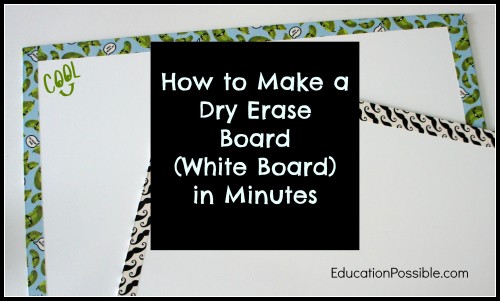
Handwriting Curriculum
Here are a couple of handwriting programs that work well for teaching your child with dysgraphia how to write.
Handwriting Without Tears
Handwriting Without Tears is an award-winning curriculum that is my number one suggestion for handwriting curriculum for dysgraphia and the one we used for several years. Just as advertised, my son progressed through the printing and cursive books without too many tears, which we considered an enormous success.
The slate chalkboard and wood pieces that are a part of the program are very helpful to reinforce the size and direction of capital letters.
Rhythm of Handwriting
Rhythm of Handwriting is another program that’s a favorite among homeschooling families. It works well for kids with dysgraphia because of its multi-sensory approach.
It focuses on the movement of each letter stroke and has verbal cues to help struggling learners.
Kids start with large motor skills where they write letters with their fingers before using a pencil. They also teach the letters in patterns, grouping them together based on initial strokes.
The instructions are short and clear, which makes it easier for children to remain focused.
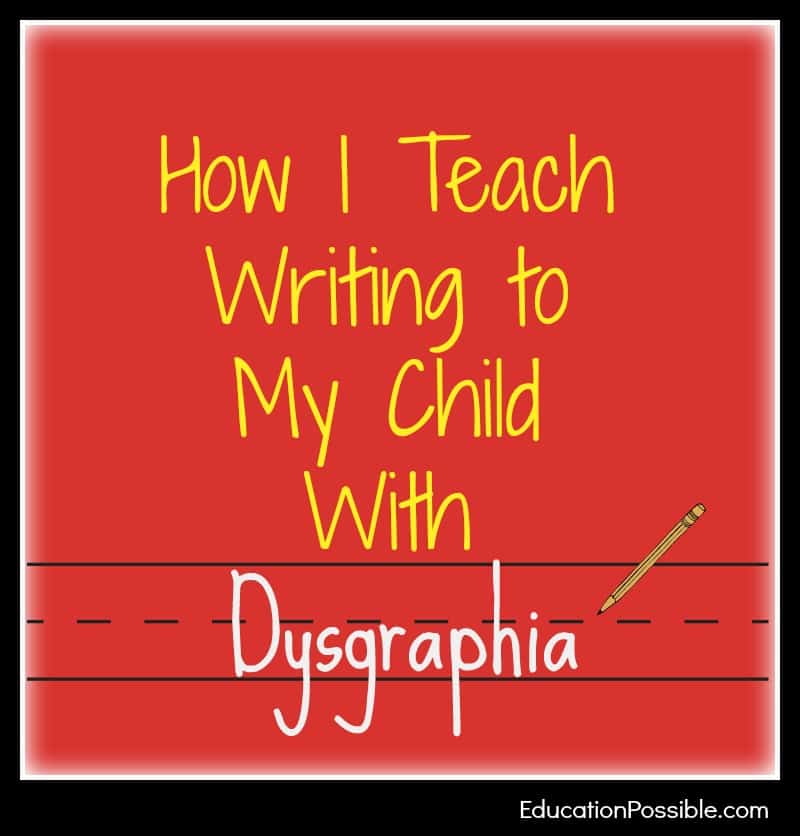
Helpful Curriculum
In addition to helping your child improve his physical writing skills, you also need to help him develop other areas of writing. While these programs aren’t specifically written for children with dysgraphia, I have seen firsthand how they can help a child with this learning disability improve their writing skills.
Spelling Smart!
Spelling can be very challenging for kids with dysgraphia, but after trying more programs than I can count, Spelling Smart! is the one that finally worked for us.
A huge benefit to this program is that it reinforces spelling patterns through word lists and various writing opportunities. The repetition makes it easier for kids to master the spelling of a wide variety of words.
Wordsmith Apprentice
If you’re looking for a fun and creative writing curriculum, Wordsmith Apprentice is a great choice. This was an early favorite of ours, and it helped my son learn many of the basics he needed to write paragraphs and essays.
Writing Rockstars
When you’re ready for a more in-depth, personalized writing instruction program, Writing Rockstars is the one you should choose.
As you know, it’s crucial for kids to build solid writing skills as they move through middle school. With this program, students learn how to write specific types of essays using a simple 5 step process.
Essay Rockstar is unique because students work through the lessons at their own pace, then submit their work to a writing teacher for feedback. The one-on-one coaching is invaluable.
It’s just the right curriculum to help teens get ready for high school level work.
They even have a free downloadable eBook called “End Blank Page Terror Forever!” It’s filled with 24 graphic organizers that are incredibly helpful for kids with dysgraphia.
One of my son’s least favorite parts of the writing process is facing a blank piece of paper when he begins a new assignment, so this was invaluable.
Tools for Dysgraphia
Check out my tools for dysgraphia shelf in my Amazon Influencer store. It’s full of all kinds of things you can use to help you teach your child with dysgraphia how to write.
Hopefully, you’re encouraged by these strategies and tools you can use in your homeschool. It’s not easy, but with persistence, patience, and helpful devices, your child can learn how to write well.
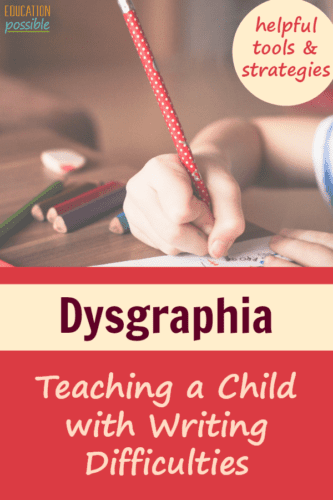
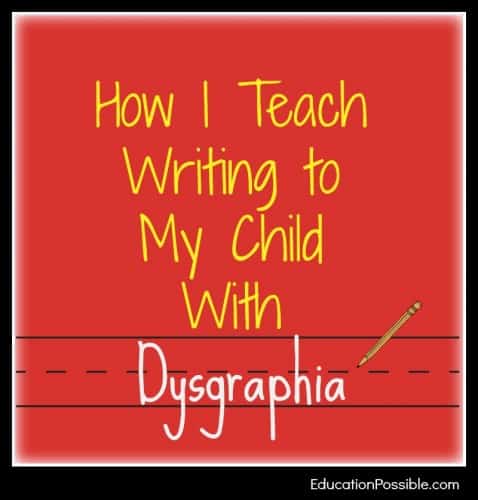

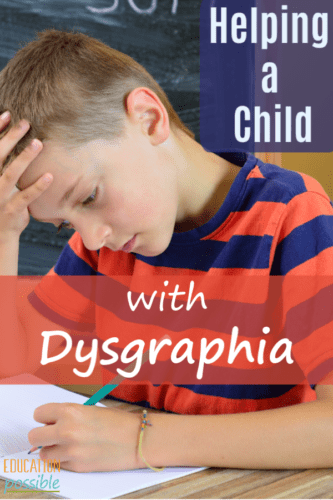

Thank you for this post. We are currently setting up testing for my 7 year old. It is believed that she has dysgraphia. I will pin this in case that is where things end up for us. Thank you again. =)
You are so welcome – thank you for pinning and sharing with other families. I would love to hear about your daughter’s testing and how you move forward. One of the hardest things for us was that I didn’t know anyone else going through what we were facing – it would be great to hear what works and doesn’t for your family and others over the years. Take care!!
Thank you so much for this post! Our 11 year old son has both dyslexia and dysgraphia and I am always looking for ways to help him learn and succeed. I have bookmarked this for future reference, but was so glad to see that I do already utilize some of your suggestions: HWT, graph paper for math, using the white board, etc.
Because this post was near and dear to my heart, I am choosing it as one of my favorites and will feature it on my Hearts for Home Blog Hop post tomorrow. Be sure to stop by and grab an “I’ve been featured” button. 🙂
Many blessings,
Lisa
Thank you Lisa! So nice to meet other families working through this. I appreciate the mention on the hop – love the button!!
Thank you so much for this thoughtful post. I have a 10 year old son who was recently diagnosed with dysgraphia, dyspraxia, dyslexia and Autism. Finding help for him has been my life’s quest. If you ever have more advise on this topic please share. I believe that mom’s, in situations like myself, desperately need insight like this to keep us going and moving in a positive direction for our children’s needs.
Trish – You are so welcome! I totally agree – we need to keep searching and sharing this information to help each other help our children. We are currently trying out a new program for teaching keyboarding skills and my son is finding it to be very helpful, I’ll have a post going up in January with all of the details. I’m also working on a list of additional resources – good news is I keep finding new things to add to the list.
I am constantly looking for things to help my 11 year old son. He has been diagnosed with auditory processing disorder, and dysgraphia. He doesn’t know all of his times tables so I believe that he also might have dyscalculia. He is a smart little guy that has to work twice as hard as most of the other kids just to get half as far. He goes to a private school. He will not be able to go there next year, and our public school system is of no help. I am looking for a math program for him can you suggest one? Also, we have covered the parts of speech, capitalization, and punctuation and they just don’t seem to matter to my son. I talk to him about them until I am blue in the face. He still cannot write a complete paragraph. We have him keyboarding as well as doing handwriting without tears. I just don’t know how to help my son. I have printed out a ton of graphic organizers and we talk about them.
Becky, I understand your concern. When compared to other kids his age, my son always felt he was “behind” in areas of math and language arts. But, we also found that he was pretty far ahead in other areas like history and computers. He learns at a different pace than others because his brain processes information differently. We talk about grammar all year, every year but he still has trouble putting that into practice too. The good thing is that because of the years of repetition the knows the information, it’s just harder for him to get it onto the page. He is a teenager now, and he still struggles a bit, so we have tried a variety of options. We have learned that for the language arts subjects he prefers more structure. Who would have guessed, but he likes to diagram sentences, and he likes to have a checklist of things to look for (punctuation, capitalization, etc.) to use to go back through is writing. Sometime he still misses things, but since he likes things to be orderly he is at least going through the process and catching some of the the items he needs to correct. We have used a number of different math programs over the years with mixed success. My son likes the online math programs — for the younger grades he did well with Aha! Math http://www.learning.com/providers/learning/ Right now we are doing a review course called Learn Math Fast – http://www.learnmathfastbooks.com/ . Khan Academy is also a great free online resource for math. The areas that are a challenge tend to get the most attention but be sure to support his overall development and confidence by encouraging the subjects he enjoys. It sounds like you are doing a lot already- you are doing a great job!.
Hi Susan I see that you are doing learn maths fast — but when I click on link it is only the books — Zach does well online — that is why I looked at the link — did I get it wrong
Also if you do answer could you please explain further in diagram sentences and all of what you put on your checklists.
I feel since his diagnosis was late that I am way behind.
Learn Math Fast is in a book format only, sorry if that caused an confusion. Even though it is book format we find that it is very straightforward when explaining new concepts and the review problems clearly reinforce the topics being taught. If you have questions about the program I would encourage you to contact the program creator directly via their website — she has answered many of my questions and offered a great deal of support as she is a homeschool parent too!
When my son was younger we used First Language Lessons to help teach sentence diagraming. We haven’t practiced this in several years. For high school we are using “Easy Grammar” to reinforce grammar concepts.
Thankyou , once again , for your assistance. I will have a look at both.
I read this and felt compelled to share my story. In second grade, I was diagnosed with dyslexia. Not many resources were available. My parents did the best they could and told me to do what I could. I learned on my own what I needed to do in school. I made it through elementary school, high school, college, a Master’s degree and a Doctoral degree. I actually hand wrote parts of my dissertation because I was more comfortable with a pen and paper than a computer. I now work as an assistant professor and I still hand write my lesson plans. Having dyslexia did NOT stop me and I am confident and certain that all your children will also succeed! Good Luck!
Beth, Thank you very much for sharing your story with us! What a wonderful inspiration!! You should be very proud of your accomplishments. We wish you continued success!
I just found out a couple of moths ago that my son has dysgraphia, and I feel so horrible for not understanding about his difficulty in writing. He has been so miserable when I thought he was just being stubborn.
Thank you for the curriculum recommendations. We had been using Handwriting Without Tears but switched to another because he was having issues. I now know it was only because of the sound of pencil to paper that was driving him crazy. I’ll be looking into your other suggestions.
Thanks again!
I’m wondering how you got your son diagnosed with dysgraphia. I think my 11 year old son might have it. My pediatrician said that the school OT could test for it, when we questioned the school, we were told they don’t do that.
We had our son evaluated by a school psychologist but it was someone in private practice, not through the school system. We are in Florida and at the time were told it would take several month to get my son an appointment through the public school system so we made the decision to find someone in private practice. If you want to find someone in your area I would look for counselors who specialize in learning/child development evaluations.
Thank you so much for this post. My youngest of three sons I believe has dysgraphia. I have not had him formally tested. He also suffers from chronic migraines and has had visual processing issues. I have been homeschooling him for the past two and a half years and writing has been a very difficult subject. I will be looking into some of the curriculum you have shared here. So far we have experienced more frustration than success, but I can’t give up!
What spelling program do you use?